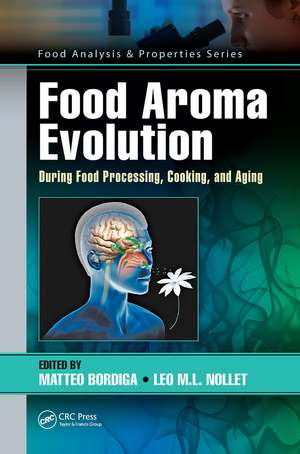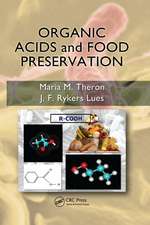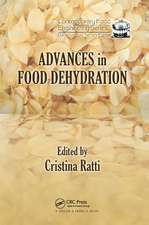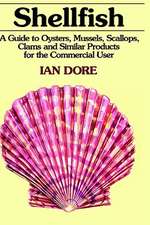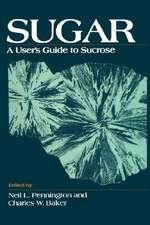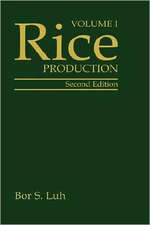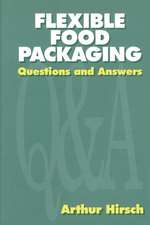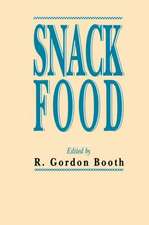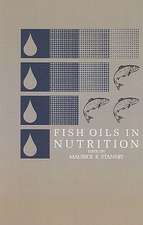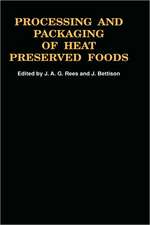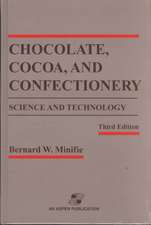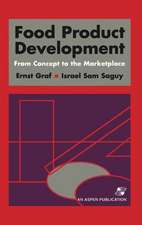Food Aroma Evolution: During Food Processing, Cooking, and Aging: Food Analysis & Properties
Editat de Matteo Bordiga, Leo M.L. Nolleten Limba Engleză Hardback – 2 dec 2019
Features
- Covers aromatic evolution of food as it is affected by treatment
- Focuses on food processing, cooking, and aging
- Describes both classic and new analytical techniques
- Explains how the flavor perception results are influenced by other food constituents
Also available in the Food Analysis & Properties Series:
Ambient Mass Spectroscopy Techniques in Food and the Environment, edited by Leo M.L. Nollet and Basil K. Munjanja (ISBN: 9781138505568)
Hyperspectral Imaging Analysis and Applications for Food Quality, edited by N.C. Basantia, Leo M.L. Nollet, and Mohammed Kamruzzaman (ISBN: 9781138630796)
Fingerprinting Techniques in Food Authentication and Traceability, edited by Khwaja Salahuddin Siddiqi and Leo M.L. Nollet (ISBN: 9781138197671)
For a complete list of books in this series, please visit our website at:
www.crcpress.com/Food-Analysis--Properties/book-series/CRCFOODANPRO
Din seria Food Analysis & Properties
-
 Preț: 356.60 lei
Preț: 356.60 lei - 15%
 Preț: 489.26 lei
Preț: 489.26 lei - 29%
 Preț: 1107.17 lei
Preț: 1107.17 lei - 18%
 Preț: 1819.06 lei
Preț: 1819.06 lei - 18%
 Preț: 1670.29 lei
Preț: 1670.29 lei - 29%
 Preț: 942.66 lei
Preț: 942.66 lei - 18%
 Preț: 1330.79 lei
Preț: 1330.79 lei - 18%
 Preț: 1342.79 lei
Preț: 1342.79 lei - 18%
 Preț: 1280.44 lei
Preț: 1280.44 lei - 18%
 Preț: 1277.45 lei
Preț: 1277.45 lei - 17%
 Preț: 351.05 lei
Preț: 351.05 lei - 22%
 Preț: 392.71 lei
Preț: 392.71 lei - 24%
 Preț: 549.97 lei
Preț: 549.97 lei - 18%
 Preț: 1286.46 lei
Preț: 1286.46 lei - 18%
 Preț: 1334.28 lei
Preț: 1334.28 lei - 22%
 Preț: 394.99 lei
Preț: 394.99 lei - 11%
 Preț: 324.28 lei
Preț: 324.28 lei - 18%
 Preț: 1272.54 lei
Preț: 1272.54 lei - 18%
 Preț: 1283.12 lei
Preț: 1283.12 lei - 18%
 Preț: 1229.96 lei
Preț: 1229.96 lei - 21%
 Preț: 390.35 lei
Preț: 390.35 lei - 22%
 Preț: 388.83 lei
Preț: 388.83 lei - 29%
 Preț: 1098.87 lei
Preț: 1098.87 lei
Preț: 1228.22 lei
Preț vechi: 1678.95 lei
-27% Nou
Puncte Express: 1842
Preț estimativ în valută:
235.09€ • 255.45$ • 197.61£
235.09€ • 255.45$ • 197.61£
Carte tipărită la comandă
Livrare economică 21 aprilie-05 mai
Preluare comenzi: 021 569.72.76
Specificații
ISBN-13: 9781138338241
ISBN-10: 1138338249
Pagini: 744
Ilustrații: 75 Illustrations, black and white
Dimensiuni: 178 x 254 x 45 mm
Greutate: 1.49 kg
Ediția:1
Editura: CRC Press
Colecția CRC Press
Seria Food Analysis & Properties
ISBN-10: 1138338249
Pagini: 744
Ilustrații: 75 Illustrations, black and white
Dimensiuni: 178 x 254 x 45 mm
Greutate: 1.49 kg
Ediția:1
Editura: CRC Press
Colecția CRC Press
Seria Food Analysis & Properties
Public țintă
Professional ReferenceCuprins
SECTION I: Aroma, taste, and flavor. 1.Aroma and Odor. 2. Flavors and Taste. 3. Chemical Senses and Flavor Perception. 4. Aroma Compounds (Description, Biosynthesis, and Regulation). 5. Orthonasal and Retronasal Olfaction. SECTION II: Analytical techniques. 6. Extraction Methods and Volatile Compounds from Food Matrices. 7. The Role of Gas Chromatography-Based Methodologies for Understanding of Food Aromas. 8. Monitoring Food Aroma during Processing and Storage by Rapid Analytical Methods: A Focus on Electronic Noses and Mass Spectrometry-Based Systems. 9. Hyphenated Electronic Nose Technique for Aroma Analysis of Foods and Beverages. 10.Food Aroma Compounds by Capillary Electrophoresis. 11. Proton-Transfer-Reaction–Mass Spectrometry. 12. Stable Isotope Dilution Assay. SECTION III: Principles of processing, evolution, and modification. 13. Food Processing, Cooking, and Aging: A Practical Case Study. 14. The Maillard Reaction. 15. Production of Food Aroma Compounds (Microbial and Enzymatic Methodologies). 16. Novel and Emerging Technologies (Benefits and Limitations). SECTION IV: Aroma compounds in food matrices. 17. Distallates. 18. Evolution of Beer Aroma. 19. Coffee Flavor. 20. Aroma Evolution in Chocolate Production. 21. Bakery Products. 22. Recent Advances in the Study of Grape and Wine Volatile Composition: Varietal, Fermentative, and Aging Aroma Compounds. 23. Milk/Dairy. 24. Meat. 25. Fish. 26. Fruits and Vegetables. 27. Spices and Herbs. 28. Off-Flavors in Alcoholic Beverages: An Overview. SECTION V: Influences on flavor perception. 29. Interactions between the Food Matrix and Aroma Compounds in Relation to Perception. 30. Food Emulsions as Flavor Delivery Systems. 31. Relationship between Structure and Odor. 32. Bioactive Potential of Sesquiterpenes.
Notă biografică
Matteo Bordiga, Leo M.L. Nollet
Descriere
Of the five senses, smell is the most direct and food aromas are the key drivers of our flavor experience. They are crucial for the synergy of food and drinks. Up to 80% of what we call taste is actually aroma. This book deals with how food aromas are developed and affected during food processing, cooking, and aging.
